1.B6U1 warming up 导学案
Unit 1《Living well》Warming Up 导学案-人教选修7精品
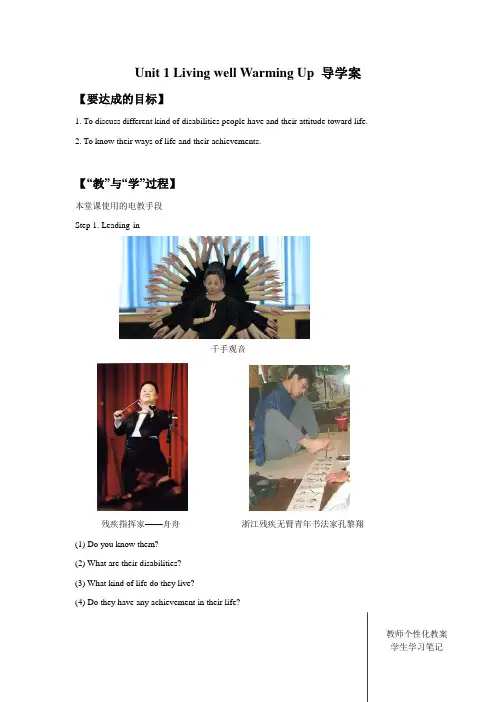
Unit 1 Living well Warming Up 导学案【要达成的目标】1. To discuss different kind of disabilities people have and their attitude toward life.2. To know their ways of life and their achievements.【“教”与“学”过程】本堂课使用的电教手段Step 1. Leading-in千手观音残疾指挥家——舟舟浙江残疾无臂青年书法家孔黎翔(1) Do you know them?(2) What are their disabilities?(3) What kind of life do they live?(4) Do they have any achievement in their life?教师个性化教案学生学习笔记Step 2. Warming Up1 Ask Ss to look at the four pictures on P1 and discuss with a partner what disabilities they may have by just looking at the pictures.2 Write the following information about the four students in the pictureson the blackboard. And let Ss talk as much as possible.3. Ask Ss to list as many words related to disabilities as possible on the blackboard.Step 3. Homework1. Ask Ss to find more stories about the disabled.2. Ask Ss to preview the reading text.【课后反思】(教师写成败得失和改进措施,学生写学习体会和存在的问题)。
Unit1_Warming_Up_and_Reading_优秀教案
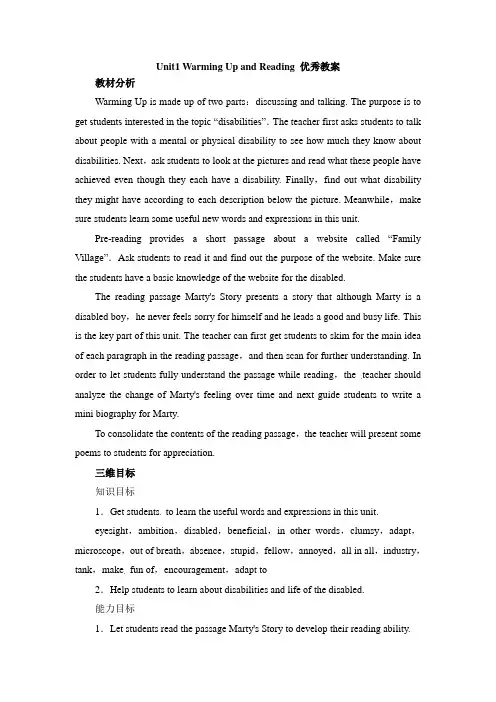
Unit1 Warming Up and Reading 优秀教案教材分析Warming Up is made up of two parts:discussing and talking. The purpose is to get students interested in the topic “disabilities”.The teacher first asks students to talk about people with a mental or physical disability to see how much they know about disabilities. Next,ask students to look at the pictures and read what these people have achieved even though they each have a disability. Finally,find out what disability they might have according to each description below the picture. Meanwhile,make sure students learn some useful new words and expressions in this unit.Pre-reading provides a short passage about a website called “Family Village”.Ask students to read it and find out the purpose of the website. Make sure the students have a basic knowledge of the website for the disabled.The reading passage Marty's Story presents a story that although Marty is a disabled boy,he never feels sorry for himself and he leads a good and busy life. This is the key part of this unit. The teacher can first get students to skim for the main idea of each paragraph in the reading passage,and then scan for further understanding. In order to let students fully understand the passage while reading,the teacher should analyze the change of Marty's feeling over time and next guide students to write a mini biography for Marty.To consolidate the contents of the reading passage,the teacher will present some poems to students for appreciation.三维目标知识目标1.Get students to learn the useful words and expressions in this unit.eyesight,ambition,disabled,beneficial,in other words,clumsy,adapt,microscope,out of breath,absence,stupid,fellow,annoyed,all in all,industry,tank,make fun of,encouragement,adapt to2.Help students to learn about disabilities and life of the disabled.能力目标1.Let students read the passage Marty's Story to develop their reading ability.2.Enable students to know that people with disabilities can also live well.情感目标1.By talking about disabilities and life of the disabled,make sure students can learn some positive stories of the disabled.2.Help them understand more about how challenging life can be for the disabled.3.Develop students' sense of cooperative learning.教学重点Get students inspired by positive stories of the people with disabilities.教学难点1.Develop students' reading ability.2.Help students understand the difficulties the disabled have to overcome.教学方法1.Task-based teaching and learning.2.Cooperative learning.教学过程Warming up1.Warming up by discussingFirst ask students to talk about people with a mental or physical disability to see how much they know about disabilities. Then show some photos of people with disabilities. Students will be asked to discuss the following questions in small groups.Do you know any famous people who are disabled?What difficulties do they have to overcome in daily life?What have they achieved?Suggested answers:Steven Hawking has a muscle disease,but he makes great contributions in science and puts forward his theory about black holes.Beethoven was deaf in one ear when he was 26 and totally deaf at the age of 35,but he was a great composer.。
Unit 1 Warming up 导学案 人教版高中英语必修一(含答案)
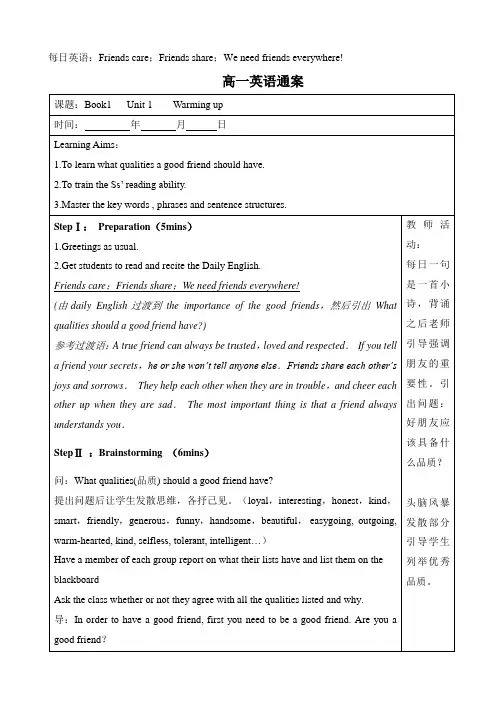
高一英语通案
课题:Book1 Unit 1 Warming up
时间:年月日
Learning Aims:
1.To learn what qualities a good friend should have.
Question 4 is concerned with responsibilities to a friend.A provides the correct amount of responsibility to your friend. You recognize that it was your fault and will put it right and pay for the damage. So it gets the highest score. B provides some understanding that you are responsible. You put the situation right but you do not pay for the damage yourself. So it does not get the highest score. C gets the lowest score because you expect your friend to pay for your mistakes even though you were doing your friend a favour.
导:In order to have a good friend, first you need to be a good friend. Are you a good friend?
高中英语必修一Unit1Warmingup教案培训资料
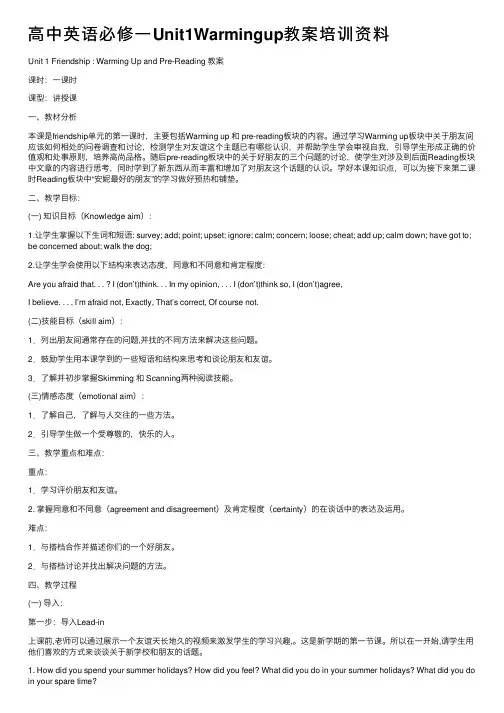
⾼中英语必修⼀Unit1Warmingup教案培训资料Unit 1 Friendship : Warming Up and Pre-Reading 教案课时:⼀课时课型:讲授课⼀、教材分析本课是friendship单元的第⼀课时,主要包括Warming up 和 pre-reading板块的内容。
通过学习Warming up板块中关于朋友间应该如何相处的问卷调查和讨论,检测学⽣对友谊这个主题已有哪些认识,并帮助学⽣学会审视⾃我,引导学⽣形成正确的价值观和处事原则,培养⾼尚品格。
随后pre-reading板块中的关于好朋友的三个问题的讨论,使学⽣对涉及到后⾯Reading板块中⽂章的内容进⾏思考,同时学到了新东西从⽽丰富和增加了对朋友这个话题的认识。
学好本课知识点,可以为接下来第⼆课时Reading板块中“安妮最好的朋友”的学习做好预热和铺垫。
⼆、教学⽬标:(⼀) 知识⽬标(Knowledge aim):1.让学⽣掌握以下⽣词和短语: survey; add; point; upset; ignore; calm; concern; loose; cheat; add up; calm down; have got to; be concerned about; walk the dog;2.让学⽣学会使⽤以下结构来表达态度,同意和不同意和肯定程度:Are you afraid that. . . ? I (don’t)think. . . In my opinion, . . . I (don’t)think so, I (don’t)agree,I believe. . . , I’m afraid not, Exactly, That’s correct, Of course not.(⼆)技能⽬标(skill aim):1.列出朋友间通常存在的问题,并找的不同⽅法来解决这些问题。
2.⿎励学⽣⽤本课学到的⼀些短语和结构来思考和谈论朋友和友谊。
高中英语必修一Unit1 Warming up教案培训资料
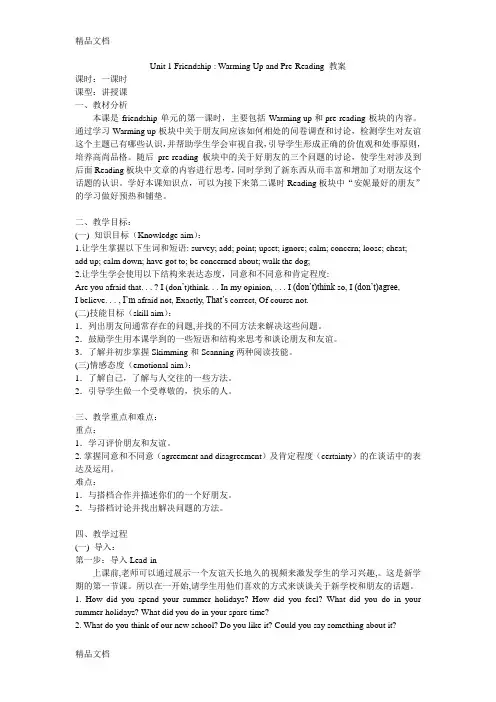
Unit 1 Friendship : Warming Up and Pre-Reading 教案课时:一课时课型:讲授课一、教材分析本课是friendship单元的第一课时,主要包括Warming up 和 pre-reading板块的内容。
通过学习Warming up板块中关于朋友间应该如何相处的问卷调查和讨论,检测学生对友谊这个主题已有哪些认识,并帮助学生学会审视自我,引导学生形成正确的价值观和处事原则,培养高尚品格。
随后pre-reading板块中的关于好朋友的三个问题的讨论,使学生对涉及到后面Reading板块中文章的内容进行思考,同时学到了新东西从而丰富和增加了对朋友这个话题的认识。
学好本课知识点,可以为接下来第二课时Reading板块中“安妮最好的朋友”的学习做好预热和铺垫。
二、教学目标:(一) 知识目标(Knowledge aim):1.让学生掌握以下生词和短语: survey; add; point; upset; ignore; calm; concern; loose; cheat; add up; calm down; have got to; be concerned about; walk the dog;2.让学生学会使用以下结构来表达态度,同意和不同意和肯定程度:Are you afraid that. . . ? I (don’t)think. . . In my opinion, . . . I (don’t)think so, I (don’t)agree,I believe. . . , I’m afraid not, Exactly, That’s correct, Of course not.(二)技能目标(skill aim):1.列出朋友间通常存在的问题,并找的不同方法来解决这些问题。
2.鼓励学生用本课学到的一些短语和结构来思考和谈论朋友和友谊。
3.了解并初步掌握Skimming 和 Scanning两种阅读技能。
Unit1第1课warming upreading(导学案)
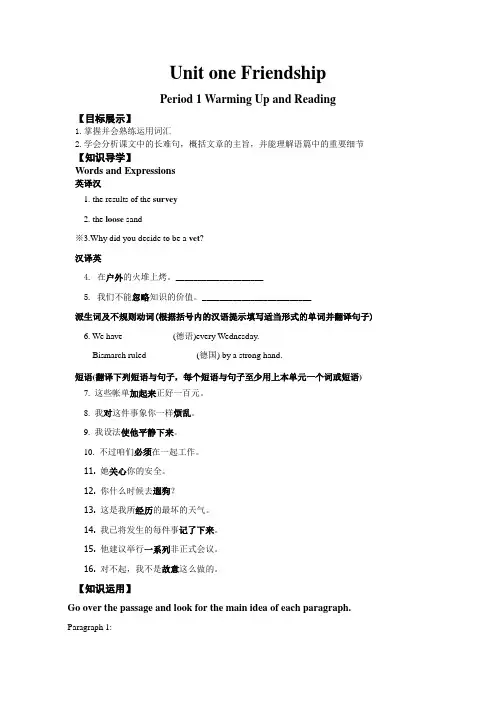
Unit one FriendshipPeriod 1 Warming Up and Reading【目标展示】1.掌握并会熟练运用词汇2.学会分析课文中的长难句,概括文章的主旨,并能理解语篇中的重要细节【知识导学】Words and Expressions英译汉1. the results of the survey ___________________2. the loose sand ___________________※3.Why did you decide to be a vet? ___________________汉译英4.在户外的火堆上烤。
____________________5. 我们不能忽略知识的价值。
_________________________派生词及不规则动词(根据括号内的汉语提示填写适当形式的单词并翻译句子)6. We have ___________(德语)every Wednesday.Bismarch ruled ___________(德国) by a strong hand.短语(翻译下列短语与句子,每个短语与句子至少用上本单元一个词或短语)7.这些帐单加起来正好一百元。
_______________________________________8.我对这件事象你一样烦乱。
_______________________________________9.我设法使他平静下来。
_______________________________________10.不过咱们必须在一起工作。
_______________________________________11. 她关心你的安全。
_______________________________________12. 你什么时候去遛狗?_______________________________________13. 这是我所经历的最坏的天气。
Unit-1-Warming-up-导学案-人教
5.Your friend comes to school very ____(upset).
6.His math makes his whole family ____(concern)about his grades in NMET.
7.I have got my hair______ (cut)
*教师精讲:句中While walking the dog是一个省略句,补全后为:While you were walking the dog。
状语从句省略的条件
when,while,before,after,unless等引导的状语从句中的主语与主句主语一致或主语是it时
状语从句谓语中含有be动词
2.T_______(又累又饿地)
*宾语补足语:
1.You had to pay to get it ____(repair).
2.Let your friend ______(borrow)it without saying nothing.
3.His math makes his whole family ____(concern)about his grades in NMET.
省略的形式
省略从句中的主语和be动词
举一反三:
①While he was reading the book,he nodded from time to time.
=Whilereadingthe book,he nodded from time to time.
②When it is heated,ice can be changed into water.
2.To train the Ss’ reading ability.
Book6 Unit1 Warmingup and reading导学案
Unit1 Book6 Warmingup and reading导学案S tepI.课前预习:1.Can you match the painting and the painters?2.Match the words with the correct meaningsa. realistic 1. state or fact of existingb. abstract 2. lifelike, true to lifec. existence 3. being in thought but having a physical or practical existenced. detailed 4. classical, of old beliefse. religious 5. accurate, minutef. traditional 6. sincere to believe in a god or godsStepII. Fast reading1.What’s the main idea of the text ?2.How many styles of Western painting are mentioned in the text? What are they?.StepIII. Skimming1.What were the artists interested in from 5th to 15th century AD?Creating _______ and ____ for God2.How did Masaccio paint his paintings?He drew things in__________, which makes pictures very _______.3.Why did the impressionists have to paint quickly?Because the natural light _______ quickly, they had to _____ quickly. StepIV. Scanning1. Which of the following statements is true?A. Paintings in Middle Ages were very realistic.B. Western art has changed a lot since the 5th century.C. Impressionist paintings were painted mainly indoors.D. Modern art began in the Renaissance.2. At first most people disliked the impressionists’ style of painting, because _____. their painting were very abstract.their painting were very realistic.They broke away from the traditional style of painting.D. their paintings were very ridiculous3. In the Renaissance, painters___.Painted religious scenes in a more realistic style.B. focused more on religion than on humans.C. began to paint outdoors.D. returned to classical Roman and Greek ideas about art.4. ____discovered how to make paintings look more real by using perspective.A.Giotto di Bondone.B.Masaccio.C.laude Monet. D. Pablo Picasso5. What does the text mainly tell us?How religious painting developed.How oil painting developed.How impressionist painting developed.D. How western art developed.StepV.:Detailed Reading: True or False1. Western art has changed very little over the last seventeen centuries.2. Painters in the Middle Ages painted mainly religious subjects.3. Paintings in the Middle Ages were very realistic.4. Renaissance painters tried to paint things in a realistic way.5. Two important discoveries in the Renaissance period were oil paints and drawing inperspective.6. Impressionists painted their pictures mainly indoors.7. At first people did not like the impressionists’ paintings.8. Modern art began with the impressionists.StepVI. Fill in the chart.。
教案:Unit 1 Warming Up
第一步引入话题1. Take advantage of the last Spring Festival and ask students what else they know about Chinese festivals, including when they take place and they celebrate and at least one thing that people do at that time.2. Ask students how much they know about foreign festivals.第二步看一看猜一猜(小组竞赛)1. Show students some pictures/photos, then ask them to guess which festival people are celebrating.2. Put a photo of “Easter” in the end, leading into the listening training.第三步听力训练(双人活动)1. (Page 41 Listening) Ask students to talk about the 3 pictures.2. Students listen to the tape for the first time and write down the main idea or just ask students to fill in the blanks like: The listening passage is about Easter. Children look for Easter eggs hidden by their parents and the family eat a special dinner of roast lamb and apple pie.3. Ask students to have a look at the six questions in Exercise 2 before they listen to the tape again.4. Play the tape and let students answer the questions.5. Ask students to exchange their information.6. Play the tape again for the students to correct their answers.第四步角色扮演:购物(双人活动)1. (Page 41 Talking) Ask students to read the situation, better choose “Easter” rather than “Spring Festival”.2. Let students read the expressions of “request”.3. Ask students to make up a dialogue in pairs, one as the shopkeeper and the other as the customer.4. Ask some pairs to present their dialogues to the class.。
学案1:Warming up
Unit 3 Under the sea学习目标:1. 帮助学生更多地了解海洋(海底)生物。
2. 培养学生热爱和保护海洋生物的意识。
3. 掌握本单元教学目的和要求中的词汇用法。
4. 学会在写作中表达责备、抱怨及要求赔偿。
学习重点:复习动词-ing形式并学习其被动式。
课前预习I. Read the passage and find out the following phrases from the passage.1. 整理住处__________________________2. 及时(做)某事;来得及____________3. 大声喊叫_________________________4. 在…前面__________________________5. 一刻不停地________________________6. 朝海湾方向驶去___________________7. 给某人带路_______________________8. 一群____________________________9. 最精彩的事______________________10. 瞄准;对准_____________________11. 放开,松手_____________________12. 翻身;转身;翻转_______________13. 在此期间,与此同时_____________14. 饱餐一顿______________________15. 靠近某人______________________16. 被稳稳地托住__________________17. 帮助(某人)摆脱困境或危难______________________II. Read the text and choose the best answer.1. What’s the main idea of this passage ?A. About a big fish which helped the fishermen.B. About great whales which helped the whalers out.C. About the whalers who were surviving on the sea.D. About the whale station where the whalers could catch the whales.2. Old Tom throws itself out of the water and then crashes down in order to _______.A. give the whalers the information about a whaleB. tell the whalers it is hungryC. help the whalers catch the whaleD. inform the whalers to run away3. Why did the men start turning the boat around to go home after the whale died?A. Because th ey didn’t need a dead whale.B. Because they couldn’t find the whale’s body.C. Because they knew that the dead whale wouldn’t float up to the surface for around 24 hours.D. They had to do this because it was too late.4. At first, it was ______ that told the whalers there was a whale for them and showed the way.A. GeorgeB. Old TomC. the writerD. James5. Which of the following is the right order according to the text?a. The killers were working as a team to attack the whale.b. The dead whale was dragged by the killers into the depths of the sea.c. We jumped into the boat with the other whalers.d. The harpoon hit the whale.A. c-a-d-bB. b-a-d-cC. c-d-a-bD. d-a-c-bIII. Replace the following sentences with sentences from the passage.1. Although I didn’t put on my clothes, I ran after George, because I had known he didn’t like waiting others._______________________________________________________________________________ _______________________________________________________________________________ 2. James’s face suggested that he was afraid of being given up by us._______________________________________________________________________________ 3. We jumped into the boat without the slightest hesitation and started out into the bay._______________________________________________________________________________IV. Analyze these sentences and translate them into Chinese.1. ①I had already heard that George __________ ________ _________ _________ ___________(不喜欢等人), so even though I didn’t have the right clothes on, I raced after him.②As we _________ __________(走近), I could see a whale__________ _____________(受到攻击)by a pack of about six other killers.③From James’s face, I could see he ________ _______________ ______ ___________ ________________(生怕被遗弃) by us.④_____ ________ over half an hour ______(花费…做) get the boat back to James, and when we approached him, I saw James ___________ ____________ _________ _______ (被稳稳地托着) in the water by Old Tom.2. ①We ran down to the shore in time to see an enormous animal opposite us ______________ __________ ______(猛力跃出) of the water and then _____________ ___________(坠落) again.②I looked down into the water and could see Old Tom ______________ ( 游着) by the boat, _____________ ______ _______ _________(为我们指路).③A few minutes later, there was no Tom, so George ____________ _____________(拍打水面) the water with his oar and there was Tom, ______________ _________(转回) to the boat, _______________ ______ ______(领着我们前往) the hunt again.④___________ ___________ _________________(受了重伤), the whale soon died.3. This was the call that announced there ________ __________ ______ ______(马上就要) a whale hunt.4. And then Old Tom was off and back to the hunt ___________(关系词) the other killers were still attacking the whale.参考答案I. 1. sort out the accommodation 2. in time to do sth. / for sth.3. yell out4. ahead of5. without pausing6. head out into the bay7. show sb. the way8. a pack of9. the most extraordinary thing10. aim (sth.) at…11. let sb./sth. go / let go (of sb./ sth.) 12. turn around13. in the meantime 14. have a good feed on… 15. approach sb.16. be firmly held up 17. help (…)outII. BACBAIII. 1. I had already heard that George didn’t like being kept waiting, so even though I didn’t have the right clothes on, I raced after him.2. From James’s face, I could see he was terrified of being abandoned by us.3. Without pausing we jumped into the boat with the other whalers and headed out into the bay. IV. Analyze these sentences and translate them into Chinese.1. ①didn’t like being kept waiting ②drew closer; being attacked③was terrified of being abandoned ④It took; to; being firmly held up2. ①throwing itself out ; crashing down ②swimming; showing us the way③started beating; circling back; leading us to ④Being badly wounded3. was about to be4. where。
- 1、下载文档前请自行甄别文档内容的完整性,平台不提供额外的编辑、内容补充、找答案等附加服务。
- 2、"仅部分预览"的文档,不可在线预览部分如存在完整性等问题,可反馈申请退款(可完整预览的文档不适用该条件!)。
- 3、如文档侵犯您的权益,请联系客服反馈,我们会尽快为您处理(人工客服工作时间:9:00-18:30)。
Book6 Unit1 Art
Period 1 Warming Up, Pre-reading
【学习目标】
1.学习单元词汇、短语。
2.通过自主学习,合作探究;了解讨论不同绘画特点。
3.简要了解绘画艺术的历史和风格,学习有关绘画艺术的词汇。
Step 1 Leading-in
What is art? Can you list some forms of art?
Step 2. W arming Up
Can you name some famous paintings and painters both home and abroad?
Some background information:
Chinese paintings have an air of living nature,harmony and peace that is not always found in the art of other civilizations. It is entirely different from Western painting,but that difference is hard to grasp and express. The following are some different forms of art:
Figure painting:It includes portraits,story painting and genre painting(风俗画)with figures as the main subject. Lines are the key point.
Landscape painting:Chinese landscape paintings can be divided into blue-and -green landscape,gold-and-green landscape,light-purple-red landscape and water ink landscape according to the colors used in paintings. The one without outlines is called boneless landscape.
Flower and bird painting:Flowers,rocks and birds are usually the main subjects of this kind of paintings. Technically,there are detailed style with colors and free style with ink.
Court painting:It refers to the works done by those professional painters employed by the royal court,or imitations of their works by other painters.
Some western painters:
Leonardo da Vinci was born in 1452 in the village of Vinci. Leonardo began his career working for a master painter in Florence. His masterpiece is Mona Lisa. Leonardo was truly a “Renaissance Man” skilled in many fields. He was a scientist and an inventor as well as an artist. He made notes and drawings of everything he saw. Leonardo invented clever machines,and even designed imitation wings that he hoped would let a person fly like a bird.
Giotto 乔托(1267-1337) was recognized as the first genius of art in the Italian Renaissance. He painted religious scenes in a more realistic style.
Van Gogh凡高(1853-1890)was a Dutch painter who went to live in southern France and helped to develop the style of Post-impressionism. His paintings typically use bright colors and have thick lines .one of the most famous ones is Sunflowers .He is also known for being mentally ill and for cutting off one of his ears and later killing
himself. Poor as he was during his life, his paintings are now extremely valuable and sold at very high prices.
Claude Monet克劳德·莫奈(1840-1926) influenced the development of impressionism. He painted everyday objects. Monet had a fascination with light and that led him to not only paint this picture, but also several others showing the same effect on different objects.
Pablo Picasso毕加索(1881-1973) Spanish artist. One of the most prolific and influential artists of the 20th century, Picasso excelled in painting, sculpture, etching, stage design, and ceramics. With Georges Braque he launched cubism (1906-1925), and he introduced the technique of collage. Among Picasso's masterpieces are Les Demoiselles d'Avignon (1907) and Guernica (1937).
Step 3. Discussing
If you could have three of these paintings on the wall of your bedroom, which would you choose? Give your reasons (theme; style; features).
These words might help you in your discussion:
The Middle Ages : religious, respect and love for God
The Renaissance: humanistic attitude ; nature/people ;oil paints;
look richer & deeper
Impressionism : light ; shadow ; outdoors; vivid ; not detailed
Modern art/Cubism : abstract ; imagination; line ;color ; shape ;realistic ;
photographs
Step 4. Conclusion
1. Good painting is like good cooking; it can be tasted, but not explained.
2. The difference between Chinese paintings and Western paintings
Step5 Homework。
